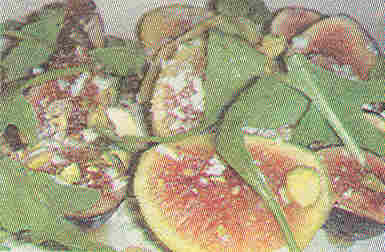 |
|
|
The Byzantine Menu
By Dimitrios Krallis
|
|
|
Any exploration of Byzantine food has to be based on a myriad of different pieces of information buried in a multitude of sources. Like ciphers from a mosaic little titbits from history, hagiography, imperial ceremonial manuals, monastic charters, comic poetry and even laws allow us to reconstitute the tastes that excited the Byzantine palate.
|
 |
|
To learn about Byzantine cuisine we need to discuss its roots in history and geography. Byzantine cuisine was a mix of local Greek practices and Roman traditions. We need to emphasize the Roman aspect of the cuisine, for our tendency is to assume that Byzantine food is automatically Greek. That was only the case in the realm of materials and even there the imprint of Rome was significant. Byzantine culinary tastes, originating in the regions where Hellenism flourished, were, in terms of its ingredients, indeed Greek. Cheeses, figs, eggs, olive oil, walnuts, almonds, chestnuts, apples, of the sweet and bitter variety, as well as pears, all constituted staples, which were indigenous to the lands of the empire and appreciated by emperor and aristocracy as well as the common people. Yet, while Byzantium was using Greek ingredients in its plates, its cuisine was at the same time much more than Greek. Byzantium was the legitimate heir to the Roman Empire and as such it traded with the world in what was an earlier version of globalization. The Byzantine emperors placed the spice sellers with their cinnamon, nutmeg and other aromas just under the windows of the imperial palace so they could get a whiff of scented breeze every time the wind blew in their direction. Constantinople, as the medieval Gotham that it was, imported everything that was to excite the discerning palate. Caviar was to be sampled next the famous garum sauce of the Romans. This latter product was made of fermented fish entrails, gills and blood. The average Byzantine table had a special container for garum soup or sauce and it seems that garum was poured on all sorts of foods. When Liudprand of Cremona, an ambassador for the German king Otto II visited Constantinople he produced what was a critical report on the meals offered to him by the emperor. Overall Luidprand, probably used to the more northern butter based cuisine, felt that Byzantine dishes were swimming in olive oil. Oil one occasion, however, Liudprand noted: [The emperor sent] to me from among his most delicate dishes a fat goat, of which he himself had partaken, deliciously stuffed with garlic, onions and leeks; steeped in fish sauce: a dish which I could have wished just then to be upon your table, so that you who do not believe the delicacies of the sacred emperor to be desirable, should at length become believers, at this sight! |
|
|
|
 Picture of Byzatine fish grill |
|
Bread was an essential staple of the Byzantine table and a guarantee of stability for the government in Constantinople. Bread in the early Byzantine era was a global enterprise. For the bakeries of Constantinople to produce the 80,000 loafs distributed daily to the people of the city, the farmers of Egypt had to produce a surplus, which they shipped on large fleets to the capital. Even in later days when Egypt was no longer part of the empire, feeding the capital was a major enterprise. The Constantinopolitans could count on a steady diet of bread, fish, much of it cured and preserved in salt, and olive oil. However, just like in contemporary Greece or Turkey, this diet was supplemented by vegetables that were produced in small gardens kept in the capital, in the smaller cities and in every village. The city of Constantinople had such a large space enclosed by its walls that most of its vegetables were produced locally. The great delicacies of the capital were then, as they are today, its fish. Surviving Byzantine laws explain in detail the rights and obliga tions of Byzantine fishermen. On the literary level, the satirical poems of Theodore Prodrdmos in the 12th century castigate the not so abstemious monks for gorging themselves with fat Bosporus catch cooked in sumptuous sauces, called Sabourai (from the Latin Sapor). Our evidence does not allow us to reconstruct Byzantine dishes. What we may, however, note is that parts of the Byzantine cooking tradition survivesinm today's Turkish and Greek cuisine. A sixth century pre-Islamic Arab source refers to stuffed zucchini and grape leaves as a quintessentially Greek dish. Today we associate these dishes with the cooking traditions brought back to the meat-eating Greeks of the Greek mainland by the refugees from Asia Minor. It seems they were Greek. On the other hand, it seems that the heavy, walnut, almond and philo-pastry deserts we eat in. both Greece and Turkey have a Persian origin. This, however, does not mean that they were not appreciated in the Byzantine court. An imperial court was open to many tastes after all. Our reconstruction of Byzantine cuisine is like the restoration of a damaged mosaic. A lot of ciphers are missing and-a lot needs to be left to imagination. Yet, the lands of Greece and Turkey, the aromas of the ingredients they produce and the living traditions of their food ultimately connect us with the realities of Byzantine food. Dimitris Krallis is Assistant Professor of Byzantine history at SFU. He has been sampling Byzantine texts history sources for the past 14 years, good food for a lifetime. |
|
|
(Posting date 28 November 2006) HCS encourages readers to view other articles and releases in our permanent, extensive archives at the URL http://www.helleniccomserve.com/contents.html. |
|
|
|
|
2000 © Hellenic Communication Service, L.L.C. All Rights Reserved.
http://www.HellenicComServe.com |
|
